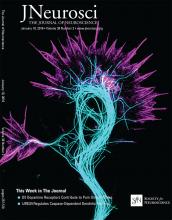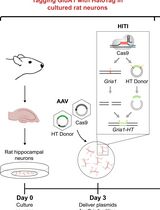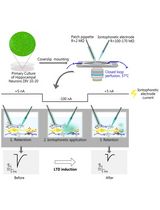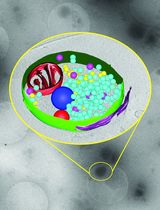- EN - English
- CN - 中文
Measurement of Dopamine Using Fast Scan Cyclic Voltammetry in Rodent Brain Slices
利用快速扫描循环伏安法检测啮齿动物大脑组织切片中的多巴胺
(*contributed equally to this work) 发布: 2018年10月05日第8卷第19期 DOI: 10.21769/BioProtoc.2473 浏览次数: 11634
评审: Anonymous reviewer(s)
Abstract
Fast scan cyclic voltammetry (FSCV) is an electrochemical technique that allows sub-second detection of oxidizable chemical species, including monoamine neurotransmitters such as dopamine, norepinephrine, and serotonin. This technique has been used to record the physiological dynamics of these neurotransmitters in brain tissue, including their rates of release and reuptake as well as the activity of neuromodulators that regulate such processes. This protocol will focus on the use of ex vivo FSCV for the detection of dopamine within the nucleus accumbens in slices obtained from rodents. We have included all necessary materials, reagents, recipes, procedures, and analyses in order to successfully perform this technique in the laboratory setting. Additionally, we have also included cautionary points that we believe will be helpful for those who are novices in the field.
Keywords: Electrochemistry (电化学)Background
Since the ability to examine the electrical properties of physiological systems was first appropriated for use in preclinical scientific research, many techniques used to study synaptic physiology have been developed. From the early days of electrophysiological recordings in squid axons to present day fast scan cyclic voltammetry (FSCV) performed in human Parkinson’s patients (Kishida et al., 2016; Lohrenz et al., 2016), the field has made significant advances in a relatively short amount of time. This protocol’s focus, FSCV, is the technical result of over 40 years of innovation and collaboration between physicists, analytical chemists, and neuroscientists. While electrochemistry was born with Michael Faraday and Alessandro Volta as early as the 19th century (Bard and Zoski, 2000), modern voltammetry did not come to fruition until the 1920s with Jaroslav Heyrovsky in his quest to measure the surface tension of mercury (Heyrovsky, 1922). Through his pursuit, Heyrovsky developed a dropping mercury electrode to perform polarography. This technique would be introduced as "voltammetry" in the United States in the 1940s and utilized platinum, gold, or carbon electrodes, in addition to the dropping mercury electrode, to study metal ions in solution. With the advent of computing technology, voltammetry methodology advanced dramatically from the late 1960s to today (for review see Bard and Zoski, 2000). Of note, in the 1970s, Ralph Adams pioneered the use of voltammetry, using a fast scanning method, in translational neuroscience specifically to study oxidizable neurotransmitters (Adams, 1976), a technique further applied to awake, freely-moving animals by Mark Wightman (Bucher and Wightman, 2015).
FSCV is a powerful electrochemical technique and is currently the only method available to directly measure extracellular levels of neurotransmitters on a sub-second timescale in discrete brain regions. One of the few comparable techniques is in vivo microdialysis–a method used to examine extracellular levels of multiple different neurotransmitters. However, even with the most recent advancements, microdialysis can only resolve neurotransmitter levels on a timescale of minutes, whereas FSCV has a temporal resolution of milliseconds. Other electrophysiological techniques utilize indirect measurements of neurotransmitter activity such as downstream postsynaptic ion channel-induced alterations in electrical signaling as a proxy. FSCV offers the unique ability to directly measure neurotransmitters in the extracellular space. This is due to the oxidizable nature of various chemical species, such as the monoamines dopamine, serotonin, and norepinephrine.
Since there are numerous publications regarding the fundamental theory of FSCV (for detailed review see: Yorgason et al., 2011; Rodeberg et al., 2017), we will not concentrate heavily on this topic here. Briefly, FSCV functions by passing an electrical current through an electrode implanted with a conductive substance such as carbon (referred to as the recording electrode), which receives electrochemical signals from a second stimulating electrode. More specifically, upon brief tissue stimulation by a bipolar stimulating electrode, dopamine is released into the extracellular space, which comes into contact with the recording electrode. A triangular waveform is passed within the carbon fiber of the electrode, ramping up to 1.2 m/sec and back down to -0.4 m/sec to detect dopamine, for example. In this way, when dopamine interacts with the carbon fiber at this specific command voltage, it rapidly oxidizes into dopamine-o-quinone, and reduces back into dopamine, which results in a signal that is communicated to the computing software. This results in the generation of a dopamine “trace” that can be modeled by the experimenter using Michaelis-Menten kinetics.
While the FSCV technique spans both in vivo and ex vivo applications, this protocol will specifically focus on FSCV execution in rodent brain slices. We will concentrate on ex vivo methods, as an analysis of current literature indicates there are few ex vivo FSCV protocols in rodent brain tissue–particularly using the new, freely available Demon Voltammetry Software (Maina et al., 2012; Fortin et al., 2015). While there are many reviews available regarding the history and theory of both in vivo and ex vivo FSCV, training in the execution of this technique in translational neuroscience is traditionally passed from mentor to mentee through direct hands-on training, with equipment often unique to each laboratory, rather than by formal instruction universal to all. Furthermore, until recently, commercial kits for FSCV were unavailable, and knowledge of these kits is still not widespread. Thus, it is imperative that trainees in the technique of FSCV be well versed in equipment usage and maintenance as well as technical performance. To this end, this protocol seeks to address technical execution of FSCV while directing the user to the tools and equipment the authors personally use to conduct experiments.
This protocol’s goal is to focus on rodent brain slice preparation, isolating a monoamine response (with a focus on dopamine in the nucleus accumbens), and data analysis. We also include a section with what we believe are helpful notes on the technique obtained from personal execution.
Brief Summary of Fast Scan Cyclic Voltammetry Procedure:
- Production of carbon fiber electrodes.
- Preparation Krebs stock solution and ACSF solution.
- Brain extraction and brain slicing using a vibratome.
- Isolation of an oxidizable neurotransmitter via stimulation of terminal fields using the fast scan cyclic voltammetry setup and Demon Voltammetry software.
- Application of pharmacological agents or variation of stimulation parameters to study desired neurotransmitter dynamics.
- Calibration of carbon fiber electrodes to identify electrode sensitivity to studied neurotransmitter.
- Model neurotransmitter signals via Michaelis-Menten fitting to obtain various kinetic parameters,using Demon Voltammetry Analysis software.
- Data exportation from Demon Voltammetry Analysis software to Microsoft Excel Spreadsheet.
- Statistical analysis using program of choice(i.e., GraphPad Prism).
Materials and Reagents
- Transfer Pipette, wide bore (Globe Scientific, catalog number: 135040 )
- Stir bar (SP Scienceware - Bel-Art Products - H-B Instrument, catalog number: F37122-0060 )
- Insulin Syringe, 28 Gauge (Fisher Scientific, catalog number: 14-826-79)
Manufacturer: BD, catalog number: 329461 . - Borosilicate Capillary Glass with Microfilament, 1.2 mm x 0.68 mm, 4” (A-M Systems, catalog number: 602000 )
- Carbon Fiber (GoodFellow, catalog number: C 005722 )
- Stainless steel conductive wire (L 3,000 x 1,000 s x 1,000 s UL 1423, UL1423 30/1 BLU) with insulated segment (Kauffman Engineering, custom made)
- Platinum wire, 0.5 mm dia, annealed (Alfa Aesar, catalog number: 43288 )
- 1 mm dia x 4 mm Ag/AgCl reference electrode (pellet form) (World Precision Instruments, catalog number: EP1 )
- Bipolar Stimulating Electrode (Plastics One, catalog number: 8IMS3033SPCE )
- Loctite® 404TM Instant Adhesive (VWR, catalog number: 300001-033)
Manufacturer: Henkel, Loctite® Professional Super Glue, catalog number: 442-46548 . - Ultrapure Water
- Deionized Water
- Isoflurane (Patterson Veterinary Supply, catalog number: 140430704 )
- Sodium bicarbonate (NaHCO3) (Sigma-Aldrich, catalog number: S6014 )
- Sodium phosphate monobasic monohydrate (NaH2PO4•H2O) (Fisher Scientific, catalog number: S369-500 )
- Sodium chloride (NaCl) (Sigma-Aldrich, catalog number: S7653 )
- Potassium chloride (KCl) (Sigma-Aldrich, catalog number: P5405 )
- Magnesium chloride Hexahydrate (MgCl2•6H2O) (VWR, catalog number: BDH9244 )
- D-(+)-Glucose (C6H12O6) (Sigma-Aldrich, catalog number: G8270 )
- Calcium chloride dihydrate (CaCl2•2H2O) (Sigma-Aldrich, catalog number: C5080 )
- L-ascorbic acid (C6H8O6) (Sigma-Aldrich, catalog number: A0278 )
- Dopamine hydrochloride (Sigma-Aldrich, catalog number: H8502 )
- Perchloric Acid (HClO4), ACS reagent, 60% (Sigma-Aldrich, catalog number: 311413 )
- 70% Ethanol solution (Fisher Scientific, catalog number: BP8201500 )
- Artificial cerebrospinal fluid (ACSF) (see Recipes)
- 10x Krebs stock solution (see Recipes)
- 1 mM dopamine stock solution (see Recipes)
Equipment
- 100 ml plastic beaker (Cole-Parmer, catalog number: EW-06020-03 )
- 1 L plastic bottle (Cole-Parmer, catalog number: EW-06058-85 )
- -20 °C freezer
- Light source (Fisher Scientific, catalog number: 12-562-21 )
- Acrylic Coronal Brain Matrix (Harvard Apparatus, catalog number: 62-0047 [for rat], 62-0050 [for mouse])
- Personna Double Edge Stainless Razor Blade (Electron Microscopy Sciences, Personna, catalog number: 72000 )
- Silver Print II (GC Electronics, catalog number: 22-023 )
- Scissors (Harvard Apparatus, catalog number: 72-8422 )
- Bone Rongeurs (Harvard Apparatus, catalog number: 72-8906 )
- SpoonulaTM Lab Spoon (Fisher Scientific, catalog number: 14-375-10 )
- Forceps (Fisher Scientific, catalog number: 10-300 )
- Scalpel (Harvard Apparatus, catalog number: 72-8350 )
- No. 13 Scalpel blade (Harvard Apparatus, catalog number: 72-8366 )
- Induction Chamber (Harvard Apparatus, catalog number: 60-5246 )
- Guillotine (Harvard Apparatus, catalog number: 73-1918 )
- Alligator clips (Mueller, catalog number: BU-34 )
- Gas Dispersion Tube (Corning, catalog number: 39533-12C )
- Medical Gas Tank, carbogen (Linde)
- Gas Regulator (VWR, catalog number: 55850-444 )
- Stirrer (Thermo Fisher Scientific, catalog number: HP88857100 )
- Vertical Microelectrode Puller (NARISHIGE, catalog number: PE-22 )
- House Vacuum Line
- Semiautomatic Vibrating Blade Microtome (Leica Microsystems, model: VT1200 S )
- Chem-Clamp potentiostat (Dagan, catalog number: CHEM-5-MEG )
- Headstage (5 Megohms) (Dagan, catalog number: 8024 )
- Breakout Box, custom made (visit pineresearch- WaveNeuro Fast-Scan CV Potentiostat for FSCV bundles offered by PINE research. Many of their bundle options include the breakout box)
- High-speed Analog Output Card (National Instruments, catalog number: PCI-6711 )
- Data acquisition card (National Instruments, catalog number: PCIe-6351 )
- Current Stimulus Isolator (Digitimer, model: NL800A )
- Temperature Controller TC-344C (Harvard Apparatus, catalog number: 64-2401 )
- Peristaltic Pump P-70 (Harvard Apparatus, catalog number: 70-7000 )
- Upright Light Microscope with Reticle (example of suitable, Olympus, model: BX53M and Microscope World, model: KR887 )
- 3-Axis Manual Micromanipulator (NARISHIGE, model: MM-3 )
- Calibration System, custom made (see Figure 5A)
- Tygon® Tubing (Sigma-Aldrich, catalog number: Z685666)
Manufacturer: Saint-Gobain, catalog number: AJK00022 . - Syringe, 5 ml (Sigma-Aldrich, catalog number: Z116866 )
- Syringe, 30 ml (Sigma-Aldrich, catalog number: Z683671 )
- T connector with stopcock (Cole-Parmer, catalog number: UX-30600-02 )
- Tygon® Tubing (Sigma-Aldrich, catalog number: Z685666)
- Single Syringe Infusion Pump (Fisher Scientific, catalog number: 14-831-200 )
- Fume hood (optional)
- Superfusion chamber (Custom Scientific, custom order)
- Clearlink System extension set with Control-A-Flo Regulator (Baxter, catalog number: 2C8891 )
Software
- Demon Voltammetry and Analysis Software Suite, available free-of-charge at the following site: https://www.wakeforestinnovations.com/technologies/demon-voltammetry-and-analysis-software/
Note: A request for a license has to be submitted in order to download.
Procedure
文章信息
版权信息
© 2018 The Authors; exclusive licensee Bio-protocol LLC.
如何引用
Readers should cite both the Bio-protocol article and the original research article where this protocol was used:
- Mauterer, M. I., Estave, P. M., Holleran, K. M. and Jones, S. R. (2018). Measurement of Dopamine Using Fast Scan Cyclic Voltammetry in Rodent Brain Slices. Bio-protocol 8(19): e2473. DOI: 10.21769/BioProtoc.2473.
- Siciliano, C. A., Saha, K., Calipari, E. S., Fordahl, S. C., Chen, R., Khoshbouei, H. and Jones, S. R. (2018). Amphetamine Reverses Escalated Cocaine Intake via Restoration of Dopamine Transporter Conformation. The Journal of Neuroscience 38(2): 484-497.
分类
神经科学 > 细胞机理 > 突触生理学
细胞生物学 > 细胞信号传导 > 突触传递
您对这篇实验方法有问题吗?
在此处发布您的问题,我们将邀请本文作者来回答。同时,我们会将您的问题发布到Bio-protocol Exchange,以便寻求社区成员的帮助。
Share
Bluesky
X
Copy link













